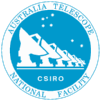Notes/MillimetreObservations?
Add notes here about things in miriad that may have to change in relation to calibration and processing of data from the mm-wave receivers.
12mm
7mmm
- 2007-09-04 Discussion with Maxim and Ilana
-
- Will the 2GHz bandwidth mean that we need to worry about opacity varying with frequency across the band?
The band covers about 32-42 GHz. It is defined by an Oxygen absorption at one end and water at the other. Probably there will not be any features to worry about, but some experiments should be done. One place to try is at Mopra which has 8GHz of bandwidth and can do dips or paddle calibration (a good summer student project, perhaps?)
The task to examine is
opcor. It's unclear how complex the frequency dependency is.Subject: RE: opacity @7mm Date: Thu, 19 Apr 2007 15:06:23 +1000 From: Bob Sault <rsault@physics.unimelb.edu.au> Reply-To: <rsault@physics.unimelb.edu.au> To: <Ilana.Feain@CSIRO.AU> Well ... my guess (without having done any analysis to half convince myself!) is that 7mm opacity could be handled the same way as 12mm opacity. At the risk of repeating material you will know already - but just to make sure we are talking the same language ... For the 12mm system, you have a system temperature measurement from the noise diode. This is a system temperature at the feed horn, rather than an above atmosphere system temperature. As such, it corrects for the effects *except* for opacity. In Miriad ATLOD, the opacity is estimated using a model atmosphere. The inputs to the model are temperature, humidity and pressure. It includes propagation effect models which are a function of frequency and elevation. It assumes clear skies (no clouds). The model will be better than nothing, but it is still just a model, and it is trying to simplify a possibly complex atmosphere to a few parameters. However the calibrator and the program source will be in the same part of the sky: the opacity difference between program source and calibrator should be small to start with, and the residual difference should be smaller still after the opacity model correction. A bigger deal is the difference in the opacity from observations of the flux calibrator and the secondary calibrator. My guess is that you can do the same at 7mm as 12mm. I assume 7mm has a noise diode?? One problem with sky dips (which I took too long to appreciate) is that the antennas are only ~60% efficient. That means that effectively 40% of the collecting area is looking at other parts of the sky. Because the lower elevations in the beam are asymmetrically "hotter" than closer to the zenith, this biases sky dips, and they do not give the right results. I found, for example, that the inferred T_receiver was always poorer when the weather was poorer - which implies the deduced opacities were on the optimistic side (note T_receiver and T_sky should be independent). --
3mm
Last modified 16 years ago
Last modified on 03/07/08 15:18:28
